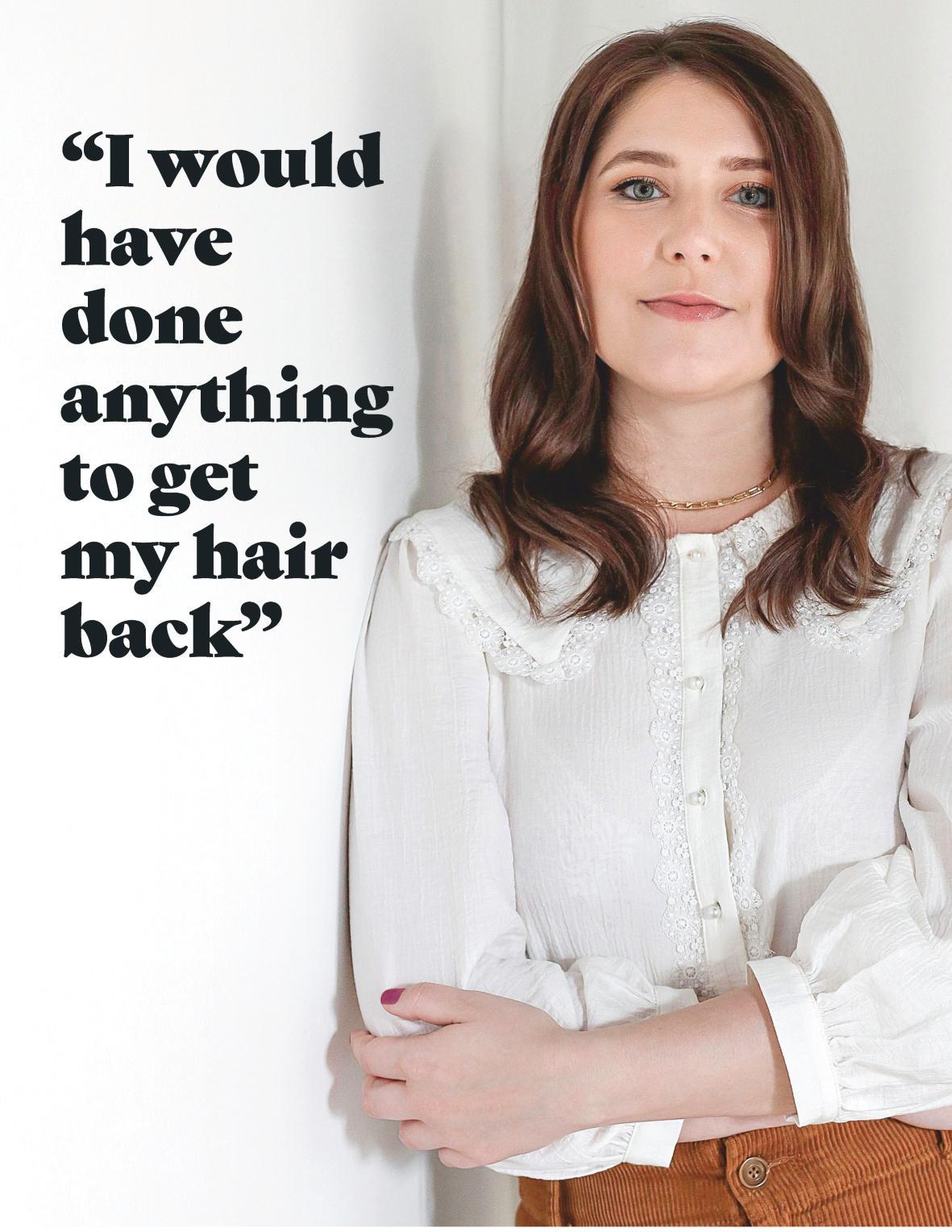
24 minute read
I would have done anything to get my hair back
More than 85 percent of women will experience some form of hair loss in their lifetime—and the mental health fallout that comes with it. Here ’ s what I learned from my own struggle with alopecia areata, and the treatments and support systems that are bringing new hope to people living with hair loss
Written by ANDRÉANNE DION
Advertisement
This is me in 2021, four years after I experienced significant hair loss and was diagnosed with alopecia areata.
PHOTO, ROSE DERAMO. HAIRSTYLING, MORGAN TULLY AT THIC STUDIO. MAKEUP STYLING, KRISTIN INNOCENT FOR HBFACE.
HEN W MY HAIR
started falling out in fistfuls and clogging up the shower drain, I barely noticed. I was 29 and halfway through a doctorate degree, juggling a demanding teaching schedule, part-time jobs and a lengthy research-based dissertation. More than anything, I was busy performing the mental gymnastics required to ignore the growing certainty that the life I had worked toward for seven years left me unfulfilled and unhappy. I’d been pushing through blindly because I couldn’t bear to face the truth: I didn’t feel passionate enough about my PhD to see it through. At the same time, I couldn’t imagine a life outside of academia, and giving up on the only career path I’d ever known without a plan seemed reckless. Though every rational fibre of my being knew those thoughts were ridiculous, I worried that my parents—who had worked hard so that I could be the first in my family to go to university—would be disappointed, that my partner would be ashamed of me and that I would resent my university friends for finishing something that I could not. The relentless pressure, guilt and anxiety of wanting to give it all up threatened to swallow me whole.
Only when my fingers skimmed a strangely smooth, palm-sized patch of bare skin at the nape of my neck did I realize what was happening: I was going bald. As an anxious person, I’d always had a long list of unlikely events I worried about, but losing my thick brown hair had never been one of them. Hair loss didn’t run in my family, and I had no idea that otherwise healthy women could experience thinning, let alone complete baldness.
As it turns out, female hair loss is shockingly common—more than 85 percent of women will experience some form of it. Shedding 50 to 100 strands a day is considered normal, but people experiencing hair loss may notice a higher volume of strands coming out in the shower and on their brush or pillowcase.
There are approximately 100 types of hair loss, though only about 20 are routinely seen by doctors. They can be triggered by a whole slew of genetic, hormonal, autoimmune and psychological factors, as well as hairstyling practices and repeated friction from head coverings, such as hijabs. The most common are telogen effluvium, which typically occurs in the months following acute emotional or physical trauma (such as childbirth, divorce, grief, job loss, certain nutritional deficiencies, thyroid problems or, say, a neverending global pandemic), and androgenetic alopecia, which is also called pattern baldness. The latter is a condition believed to have genetic and hormonal causes; it’s perhaps most commonly known to affect men as they age, though more than 40 percent of women will develop it, often after menopause.
A few weeks after I found that patch— along with several smaller ones—my doctor confirmed what I already knew from desperate Google searches: I had alopecia areata, an autoimmune condition that affects about two percent of the population. It happens when the body fails to recognize the follicles’ immune privilege (which allows hair to grow without being seen as a threat) and attacks them, leading strands to rapidly fall out in round patches and inflammation to set in, thus preventing new growth. Most people diagnosed with alopecia areata develop just a few spots, but 15 percent go on to develop alopecia totalis (complete loss of hair on the scalp) or alopecia universalis (complete

Two of the hundreds of photos I took in 2017 to document the spread of my bald patches. As my hair loss accelerated, my life came to a complete halt. I stopped going out and seeing friends; instead, I hid in my room. Eventually, a friend marched me down to our university ’ s mental health services office for an emergency session with a therapist.
loss of hair on the scalp and body). The condition is unpredictable, and while 90 percent of people eventually see regrowth, hair loss often recurs.
“Individuals with alopecia areata are born with genes that can cause it, but that doesn’t mean that they ’re going to develop it, ” explains Dr. Jeff Donovan, a boardcertified dermatologist, hair-loss specialist and president of the Whistler, B.C. –based Canadian Hair Loss Foundation. “There has to be some other trigger or environmental factor that happens later in life. ” (In my case, it was extreme distress over my life choices.)
While trauma—physical and emotional— and acute stress have been proven to be common triggers for certain types of hair loss, hair loss itself can have severe consequences on mental health and emotional well-being. “Studies have shown that people going through hair loss, and women specifically, may be at higher risk for developing major depressive disorders, anxiety disorders and social phobias, ” says Negar Amirfarhad, a registered psychotherapist who routinely works with alopecia and cancer patients at Women’s College Hospital in Toronto. She notes that while it’s easy to discount the loss as being “just hair, ” anyone who has gone through it—or even just a particularly disastrous haircut—knows it’s so much more than that. Watching your hair go down the drain is life altering and lonely. “Hair loss might be of little consequence to others, but to the person who is going through it, it can be extremely traumatic, ” adds Amirfarhad. She notes that it can trigger a grief response, which, by nature, is isolating: “Only the person experiencing it can know the magnitude of the impact. ”
At age 33, three months after having her first child, Shikha Kasal’s luscious pregnancy hair started shedding. This is a normal process: Elevated estrogen and progesterone levels during pregnancy keep the hair in a prolonged growth cycle, which leads to a thicker mane. When hormone levels drop after birth, the cycle enters a resting phase and hair starts falling out. The growth cycle then levels out about six months to a year postpartum. However, the fact that pregnancy hair loss is common doesn’t minimize the distress it causes.
Kasal—who is based in Toronto and is the co-founder of Havah, a hair oil brand that is rooted in Ayurvedic tradition— thought she might be spared severe shedding due to her stellar haircare routine. In reality, her hair thinned out so much that her scalp was visible when she wore a ponytail. “Being a first-time mom was already a stressful experience. Aside from the emotional and mental trauma that comes with it, your body is changing, too, ” she says. “It was disheartening to lose my hair, because I was grappling with so many physical changes. ”
On the advice of a friend, she cut her hair short, hoping to hide the extent of the shedding. Eventually, she just let it run its course, as postpartum hair loss usually resolves itself. In Kasal’s case, it lasted for about a month. (If excessive shedding doesn’t cease after a year postpartum, see your doctor—this could indicate a thyroid issue or nutritional deficiency.)
For Black women, whose hair is constantly scrutinized, hair loss can be particularly devastating. Christal Malcolm, a 43-year-old administrative assistant and alopecia advocate from Scarborough, Ont., has been living with central centrifugal cicatricial alopecia (CCCA), a rare form of the autoimmune disease that may lead to permanent hair loss, for more than 20 years. Her condition left her feeling isolated and unable to participate in the weekly haircare routine that she had enjoyed from a young age.
“Growing up, Sunday was wash day. My mom would put oils in my hair and braid it. It was a loving process and it became a ritual at home, and later at salons, ” she recalls. “When I started losing my hair, that sense of excitement, happiness and fun was no more. The ritual became filled with anxiety. ” Malcolm’s sense of belonging to her community was shaken. “I was angry because, as a Black woman, my hair is my

9 0 % O F P E O P L E W H O E X P E R I E N C E A L O P E C I A A R E ATA W I L L E V E N T U A L LY S E E R E G R O W T H — B U T H A I R L O S S O F T E N R E C U R S D O W N T H E R O A D .
crowning glory and a way to express my creativity, ” she says. “I felt like I was losing that and I had no control over it. ”
WITH SO MANY potential triggers and overlapping factors at play, identifying the root cause of excessive shedding is the first step in devising a treatment plan. Your doctor can rule out any health-related triggers through blood work. From there, a dermatologist referral is usually advised, and that may take as long as a year,
TELOGEN EFFLUVIUM What it is
A form of hair loss that happens when strands transition from their resting phase to their shedding phase prematurely. Hair looks thinner all over, though there are generally no bare patches. Common causes include acute stress or trauma, thyroid issues and low iron levels, as well as the fluctuating hormone levels that occur postpartum.
How it’s treated
Blood work is required to rule out or address chronic conditions, such as thyroid issues and nutritional deficiencies. Treatment options are based on the root cause and can include lifestyle changes; supplements (under the guidance of a medical professional); and treatments containing minoxidil (such as Rogaine), many of which are available without a prescription.
ANDROGENETIC ALOPECIA What it is
Also called pattern hair loss, androgenetic alopecia is believed to have both genetic and hormonal causes. It leads to decreased volume, with women noticing a wider part and a more visible scalp, rather than the M-shaped receding hairline usually observed in men.
How it’s treated
There is no way to fully reverse pattern hair loss. However, it can be stabilized— and even partially improved, in some cases—with a variety of treatments, including minoxidil and anti-androgen tablets that regulate the hormones that may be accelerating hair loss. Low-level laser therapy can stimulate circulation and promote hair growth, while injections of platelet-rich plasma can promote cell growth and regeneration. Undergoing a hair transplant is another option.
ALOPECIA AREATA What it is
Alopecia areata is an autoimmune disease in which the body attacks hair follicles, causing the hair to fall out in round patches and inflammation to set in. It affects about two percent of the population and can progress to alopecia totalis (complete loss of hair on the scalp) or alopecia universalis (complete loss of hair on the scalp and body, including lashes and eyebrows).

How it’s treated
Steroids, either topical or injected under the scalp, are highly effective for those experiencing milder forms, but in more advanced cases immunosuppressants are typically recommended to stop the immune system from attacking hair follicles. Clinical trials have shown promising results for a sophisticated new kind of immunosuppressant called JAK inhibitors, which target specific pathways in the immune system.
TRACTION ALOPECIA What it is
This type of hair thinning—caused by repeated pulling on the root—is most often associated with hair styling practices, such as tight ponytails, braids and buns, or the friction caused by weaves, wigs or head coverings, like hijabs.
How it’s treated
Prevention is key. Minoxidil can help hair grow back, but changing your styling routine is the first step. Silk caps worn under head coverings can also help decrease the friction that causes hair to fall out.
ANAGEN EFFLUVIUM What it is
Cancer treatments, such as chemotherapy, radiation therapy, hormonal therapy or targeted therapy, cause this type of hair loss. It affects the entire body but especially the scalp. Hair may progressively thin out or fall out in clumps.
How it’s treated
There ’ s currently no treatment proven to prevent or stop it. Cooling caps—which, as the name implies, cool the scalp— can help decrease blood flow so follicles are less likely to be damaged by chemotherapy, but they can ’t completely halt hair loss. Hair typically starts growing back two to six months after the end of treatments, and it may temporarily grow in a different colour or texture. Permanent hair loss can occur, but is relatively rare.
depending on where you live. These long wait times can exacerbate the physical and emotional toll of hair loss—as can dismissiveness from medical professionals.
Though she started losing her hair in her late teens, Malcolm was in her 30s when a scalp biopsy revealed she had CCCA. The first dermatologist she saw in her early 20s simply referred to her condition as “alopecia, ” which, when used alone (not in conjunction with, say, “areata” or “totalis”), is a general term that simply means “hair loss. ” From the start, the relationship was strained. “The first thing they said when they saw me was, ‘You’re the fifth patient I’ ve seen today with [hair loss], ’ ” she recalls. “They just looked at my scalp and wrote a prescription for a shampoo and a medicated serum. ”
CCCA is a scarring form of hair loss, in which the follicles are destroyed and replaced with scar tissue. It’s associated with a host of symptoms, including itching, burning, redness, scalp inflammation and painful pimples, all of which Malcolm displayed at the time she saw her first dermatologist. According to Donovan, these kinds of symptoms have to be addressed promptly, otherwise the damage can spread and become permanent.
“It was such a terrible experience, so I tried to navigate my hair loss on my own, ” says Malcolm. It took her 10 years to find a doctor she trusted, who was able to get the painful symptoms under control and give her the answers she needed to start healing, both physically and emotionally.
Her experience with CCCA led Malcolm to seek help for her mental health—not just for hair loss but also for other things that were going on in her life. Untangling her sense of worth from external relationships was crucial to her journey. “Losing my hair was the last thing in a long list of events that stripped me of who I thought I was, ” she says. “Once I sorted out those other feelings, I was able to relearn how to love myself as a whole, and it made the process of losing my hair permanently a little easier to bear. ”
Brianne Cail, a 30-year-old social media manager, wasn’t worried when she found a nickel-sized patch of scalp at the top of her head in the fall of 2020, when she was living in Midland, Ont. She’d gone through stress-related hair loss in college, and her hair had eventually come back as thick as before. When the spot grew to the size of a toonie, her doctor suggested waiting to see how it developed—due to the pandemic, in-person appointments were impossible and Cail wasn’t offered a virtual option. Three months later, she was finally referred to a dermatologist (without ever being able to see her doctor for blood work); by then, the original patch had grown to Brianne Cail shaved her head in June 2021 to regain a sense of control after her hair started falling out due to alopecia areata.

the size of a softball and more had developed. When a cancellation allowed her to meet with the dermatologist three months ahead of schedule, her alopecia areata was too advanced for topical treatments or steroid injections under the scalp, which suppress the immune response. “For patients with two or three patches of hair loss, steroid shots regrow hair in about 90 percent of people, ” says Donovan. The key is to catch the problem early, as this treatment doesn’t work as well on extensive hair loss and not at all in patients with alopecia universalis and totalis.
Instead, Cail’s hair loss progressed, marbling her scalp and making it increasingly difficult to hide or style. She ended up shaving her head to regain a sense of control, and eventually went back on the antidepressant she had previously stopped, which helped her manage the stress and anxiety caused by hair loss, among other triggers. “I still feel bitter, ” she says. “I can’t help but wonder: If I had been taken seriously from the start, would I have lost nearly all my hair?”
LIKE MANY OF the women I spoke to for this piece, I felt like I had brought my hair loss on myself; if I had just been able to get my stress under control, it might not have happened. My bald patches were easy
to conceal, so no one knew what I was going through except for my doctors and my closest friends—who all told me that my anxiety about my hair loss would exacerbate it. That well-intentioned advice only made me feel worse. I couldn’t eat. I couldn’t sleep. I couldn’t think of anything else. On the rare occasion when the panic receded, it just made space for all-consuming guilt. Physically, I was perfectly healthy. It felt vain to get so worked up over a few thousand strands of hair.
As my hair loss accelerated, my life came to a complete halt; I stopped going out and seeing friends. Instead, I hid in my room, but I couldn’t focus long enough to make progress on my PhD work. Finally, a friend marched me into our university ’s mental health services office for an emergency session with a therapist. I dutifully started going to weekly appointments and doing my therapy homework, quickly realizing that I was prone to catastrophizing. Soon, the semester came to an end and so did my time in therapy. Though it helped me confront the fact that I was unhappy in my career path, when it came to my hair loss, I felt my therapist didn’t grasp the urgency of my feelings. (I also couldn’t help but feel bitter about her long, glossy locks.) I would have suffered any amount of pain and spent all the money I had to get my hair back.
This specific type of desperation is ripe for exploitation. Hair-loss treatments and wellness supplements are lucrative categories of the beauty industry. The former is forecasted to be worth $4 billion by 2025, while the latter generated $57.28 billion in 2020. But there’s no quick fix. Some products—scrubs, volumizing treatments and other styling formulas—may temporarily give the illusion of thicker or denser strands. Others, like minoxidil, also sold under the name Rogaine, have been proven to work well for certain forms of hair loss like telogen effluvium and androgenetic alopecia. (Minoxidil helps keep hair in its growth phase longer, though progress is lost once treatment is stopped.) Supplements—such as the gummy vitamins celebrities are paid to promote on social media—are nearly always useless.
“If you are experiencing hair loss due to a thyroid or autoimmune condition, a hair supplement is not going to help, ” notes Donovan. Dr. Renée Beach, a dermatologist and the head of the hair-loss clinic at Women’s College Hospital in Toronto, cautions against trying supplements without
Hair loss myths, busted
1 Shaving your head will stimulate hair growth
The hair that we can see and touch on our scalp is dead, so cutting or shaving it won ’t affect how quickly it grows. “The root determines the growth rate and schedule, and shaving doesn ’t affect the hair root, ” says Dr. Renée Beach, a dermatologist and director of the hairloss clinic at Women ’ s College Hospital in Toronto.
2 You should avoid washing and styling your hair
A common reaction to excessive shedding is to stop touching your hair as much as possible. But the truth is that keeping up with your routine isn ’t going to accelerate hair loss. “The hair that wants to fall out will find a way and a time to fall out, ” says Beach. Shampooing your hair a few times a week may also be less traumatic than a weekly wash. “You ’ll see less shedding each time than if you wash your hair once a week, at which point you might see 500 hairs come out, which is terrifying, ” says Dr. Jeff Donovan, a board-certified dermatologist and hair-loss specialist.
Another consideration: The more often you wash your hair, the less likely you are to develop seborrheic dermatitis, a condition caused by increased sebum production that inflames the scalp. As a result, it can become itchy, and scratching can damage the hair shaft and cause more hair loss.
3 You got it from your dad
Androgenetic alopecia, which has a known genetic component, is not easy to predict. “Patients often focus a lot on what their dad’ s hair looks like, but you really need to see the family tree two generations back at advanced ages to have a really good understanding of hair-loss patterns, and most people don ’t have that luxury, ” explains Donovan. “Genetic hair loss comes from both sides of the family, ” he says, and there are also other factors at play, such as hormones.
4 Biotin supplements help with hair loss
Beach cautions against biotin, also known as vitamin B7, as it has not been proven to promote hair growth and can actually be dangerous. “We only need about 130 micrograms of biotin a day, which we get through our diets. The 5,000 micrograms we often see in supplements can instead lead to acne, distorted thyroidtest results and even mask troponin, a protein used to detect heart attacks. ”
the guidance of a medical professional. She warns that high doses of biotin, which is often touted as a miracle hair-growth booster, can cause acne and distort some medical tests.
That said, there are some promising new developments. According to Donovan, there are more than 40 drugs currently in clinical trials for various forms of hair loss. Anne-Lise Nadeau, a 42-year-old singer and actor from Saint-Damase, Que., has lived with alopecia areata since she was five; two instances were so severe that she ended up shaving her head. In August 2021, after spending 10 months in a clinical trial for a new generation of immunosuppressant medication called JAK inhibitors, her hair started growing back.
“There are still thin spots at the back, but I can feel hair there when I run my hand through it, ” she marvels. Cail has also been on JAK inhibitors for more than nine months; it took just a month for her to notice peach fuzz growing in. While alopecia areata has been treated with potent immunosuppressants in the past, they came with a bunch of undesirable side effects, such as nausea, liver irritation and the reduction of red cells, white cells and platelet levels in the blood. “JAK inhibitors are much more specific, targeting one pathway in the cell rather than a multitude of pathways, leading to fewer side effects, ” explains Donovan, noting that there are also other drugs in the
pipeline for alopecia areata, though JAK inhibitors have been a focus of late.
My own hair grew back, too, thanks to monthly steroid injections and a major lifestyle change. (I took a one-year medical leave from my PhD and then decided to quit. The relief was immediate.) At first, my regrowth was thin, wispy and white, but it eventually turned brown, and the palmsized spot filled out with enough hair to be mistaken for a grown-out undercut.
When I started opening up about my hair loss with my wider circle, I was shocked to find out that many people I knew had also experienced it—and that we’d all gone through it in silence.
As recently as five years ago (when I was desperate for guidance myself), online searches for women experiencing hair loss pulled nothing but pleas for help and bleak stories shared on discussion boards. Now, a growing online community is helping to shed the stigma. American model Christie Valdiserri—who famously took off her wig while walking a Sports Illustrated runway show in 2019—created the Baldtourage, a group where women who experience hair loss can share their stories and find support.
“The connections I’ ve made there changed my life, ” says Malcolm.

“ I C A N U S E T H O S E 2 0 Y E A R S O F G R I E F A N D H E A R TA C H E T O B E A B E A C O N O F L I G H T T O O T H E R P E O P L E .
After living with her pain in silence for 20 years, Malcolm is now making up for lost time. She’s an active member of several alopecia communities, she runs a blog and YouTube channel called the Peckish Palate, where she shares her experience with hair loss, and she mentors and advocates for people with alopecia through the Baldtourage and the Canadian Alopecia After this photo was taken, Anne-Lise Nadeau ’ s hair started growing back thanks to a promising alopecia areata drug that’ s currently in clinical trials.
Areata Foundation, for which she also serves as a board member.
“I still have my highs and lows; some days I just wish I had hair on my head, ” she says. “But I can use those 20 years of grief and heartache to be a beacon of light to other people. ”
Nadeau, who shares the realities of life with alopecia areata on her blog, Tête Libre, hopes to normalize hair loss through her online presence, her acting work and, eventually, a documentary. Shaving her head helped her take control and accept her condition, as did opening up about her journey online.
Kasal also notes the importance of speaking out, saying she found solace in talking about her experience with others who had experienced postpartum hair loss.
“Hair is a big part of our culture, ” she says.
“South Asian women are known for having this long, thick black hair. So when you’re going through [hair loss], you feel like it’s only impacting you. ”
The pain and trauma of the year I spent wondering if I would lose all my hair stays with me. I still mindlessly run my fingers over the formerly bald areas several times a day, to check that my hair is still there. I’ ve also developed an elaborate monitoring routine. Each day, I try to ballpark how many strands I lose in my brush and in the shower. Every night, I inspect my hairline and my part. I even devised a mirror system to check the back of my head for bald spots. My partner has reluctantly gotten used to checking my scalp a few times a week as well. We’ ve gotten into more arguments than I can count over whether he’s lying to me about the thickness of my hair (the jury is still out).
When I started reporting and writing this feature, my hair-loss nightmares— which I experienced frequently five years ago, when my hair first started falling out—came back with a vengeance. Looking at photos of my bald spots resurfaced all the fears I thought I had left behind when my hair grew back. I was surprised by the intensity of those feelings, but Amirfarhad notes the underlying shame, vigilance and anxiety that comes with hair loss can often stay with us even after regrowth. Instead of a complete recovery, she says, it’s about learning to live with the fear that hair loss could happen again.
I still wrestle with the fact that I can’t control what’s going to happen to my hair— and with the knowledge that my alopecia areata will likely recur. But connecting with women who have gone through similar experiences was healing in a way I didn’t expect or think I needed at this point in my journey. I may not be able to avoid losing my hair again, but now I know I’m not alone.











